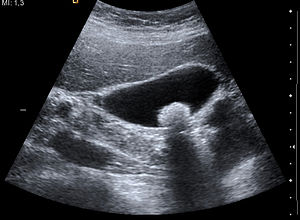Gallbladder Disease
Types[edit | edit source]
• Cholelithiasis (gallstones)
Are mainly composed of cholesterol (80%) or bilirubin calcium salts (also known as pigmented, 20%). It normally occurs after hypercholesterolemia and hypomobility of the gallbladder. They are normally yellow / white and can block the cervix of the gallbladder. Patients complain of aching or feelings of pressure in the upper right abdomen that may spread towards the right shoulder especially after fatty meals.
• Cholecystitis
Is normally associated with gallstones. In acute cholecystitis, the gallbladder is enlarged and bright red or black (due to subserosal haemorrhages) and the serosal covering is layered by fibrin and sometimes suppurative exudate. Chronic cholecystitis may develop after bouts of acute cholecystitis; the gallbladder can appear as atrophic, normal or enlarged, with severe fibrosis of submucosa and subserosa.
• Choledocholithiasis
Is the presence of stones within the biliary tree, which may be dislodged from the gallbladder or form in the duct.
• Cholangitis
Is a acute inflammation of bile duct walls, almost always caused by bacterial infection of the normally sterile lumen. It can result from any lesion obstructing bile flow, most commonly choledocholithiasis. Uncommon causes including tumours, acute pancreatitis and benign structures. Bacteria generally don’t enter the biliary tract through the blood but through the sphincter of Oddi. Usual pathogens are E. coli, Klebsiella and Clostridium.
Gallbladder tumours include carcinomas (develop from the epithelial lining of the organ – they are either exophytic or endophytic, predominantly adenocarcinomas with a high chance of invasive spread to the liver) and cholangiocarcinomas (adenocarcinomas with biliary differentiation from cholangiocytes, primarily at the hilum – well differentiated).
Diagnosis[edit | edit source]
Most commonly used is ultrasound for gallstones, but can also use x-rays, CT (for infections) or endoscopic retrograde cholangiopancreatography (ERCP).
Treatment[edit | edit source]
Avoidance of fatty meals, painkillers, medications to dissolve stones (drugs made from bile acid such as ursodiol) or if necessary, laparoscopic cholecystectomy.
Links[edit | edit source]
Related Articles[edit | edit source]
Bibliography[edit | edit source]
References[edit | edit source]
KUMAR, – CLARK,. Clinical Medicine. 8. edition. 2012. ISBN 9780702044991.



